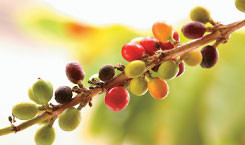The Coffee Plant Coffea
Everyone knows the little brown beans and their uniquely aromatic smell. But where do these beans actually grow? This is a short overview of the plant it all starts with: Coffea, a pretty exceptional genus of plants that became the loyal companion of humanity many thousand years ago.
Coffea is a genus with over one hundred sub-species and belongs to the family of Rubiaceae. Even though modern food culture is trending towards more and more diversity, in the world of coffee only to varieties are of real economic significance. 98% of the worlds coffee production consist of the varieties Coffea Arabica and Coffea Canephora, the plants that carry Arabian, also called Arabica and Robusta coffee beans.
Coffea species
4 species or varieties belong to the plant genus COFFEA:
Arabica (Coffea arabica)
Robusta (Coffea canephora)
Liberica (Coffea liberica)
Excelsa (Coffea excelsa)
Arabica beans account for the largest share of the coffee market with a share of 60%; Robustabohnen accounts for around 36%, while Liberica and Excelsa share the rest with a share of 3-4%.
What Does A Coffee Plant Look Like?
 With strong, dark green leaves with wavy edges, the evergreen shrubs look a little bit like the European laurel bushes. Depending on the type of coffee variety, the plants can grow up to a tree-like size and shape of 12 meters. But for commercial use and simple harvesting and pruning, the plants are normally kept at an easy to handle size of two to three meters. The oval shaped leaves measure 10 to 15 cm and grow in pairs, always sharing a fork with the white, bushy flowers. During full bloom, the flowers reach a diameter of about two centimeters and exude a pleasant but intense scent. Other than Coffea canephora, the Coffea Arabica Variety, sometimes called “mountain coffee” because of its preference of elevated areas, can pollinate itself. Depending on the type, the arrangement and appearance of the flowers and leaves can vary.
With strong, dark green leaves with wavy edges, the evergreen shrubs look a little bit like the European laurel bushes. Depending on the type of coffee variety, the plants can grow up to a tree-like size and shape of 12 meters. But for commercial use and simple harvesting and pruning, the plants are normally kept at an easy to handle size of two to three meters. The oval shaped leaves measure 10 to 15 cm and grow in pairs, always sharing a fork with the white, bushy flowers. During full bloom, the flowers reach a diameter of about two centimeters and exude a pleasant but intense scent. Other than Coffea canephora, the Coffea Arabica Variety, sometimes called “mountain coffee” because of its preference of elevated areas, can pollinate itself. Depending on the type, the arrangement and appearance of the flowers and leaves can vary.
After a couple of days of exuding their fine scent, the flowers already fade, leaving behind the ovary. Slowly, the ovaries turn into the coffee fruits, commonly called “cherries”. The ripe cherries display depending on the variety, mostly red to yellow colors, sometimes even gray to black coloring. Underneath the firm, shiny outer skin the pulp is found. Even though it has a sweetish note to it, it is not considered very tasty. Embedded in the pulp and protected by the silver skin and another fine layer sticking tightly to it, the actual seed, the coffee “bean” is located. They are green or beige and finally get their brown color from the roasting process.
Where Is Coffee Grown Today?
Thanks to the ambitious distribution and circulation of coffee by the colonial forces, coffee plantations can be found in over 80 countries today. In about 50 of these, coffee plays a major role in the country’s economy and especially in their trade. The coffee plants prefer stable weather conditions with temperatures between 17 and 30 °C and annually downfalls of 1200 to 2000 mm. With a maximum distance of 5000 km from the equator, important coffee cultivation areas are Brazil, Colombia, Peru, Costa Rica, Mexico, Vietnam, the Philippines, Indonesia, China, Uganda, Tasmania, Ethiopia and Madagascar.

